What Kind Of Animals Eat Pine Trees
To the primary carte du jour here!
THE Winter OF OUR NORHTHERN NATURE:
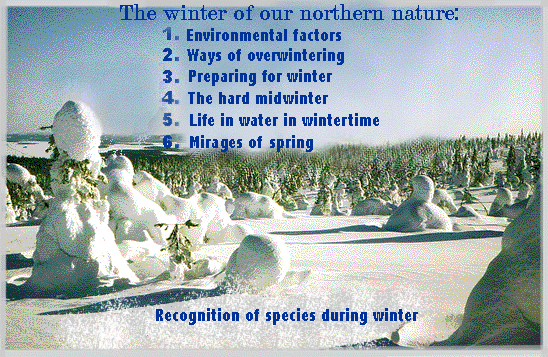

Hard midwinter/animals :
Sorry but some parts and links are not yet translated!
The link to the difficult winter of plants above (here).
Other topics on our northern nature are establish from the picture above.
For other topics concerning nature, go to Main carte du jour
In this office: 'Hard midwinter/animals', part 3.
Encounter too the wintering means of animals! and
How animals ready for the wintertime!
... and:

Hard midwinter/animals:
Winter diet cannot compete with what summertime has to offer...
The nutrition bachelor in the winter is sparse and in depression free energy value. Squirrels can run out of cones and bullfinchs out of seeds! Though there are plenty of pine twigs for capercaillies and wide leaved trees for hares this sort of nutrition is usually relatively poor in diet.

In the winter, many animals eat food stock they take gathered - if they can find them and the supplies have not been eaten past other animals!
The nutrition of most herbivorous animals is totally different in the wintertime: a lot dryer, harder and ja woodier. In improver, a function of the food plants have either withered or been covered past snow.
A long appendix contributes to eating woody twigs for nutrition (for example past hares or capercaillies) Eg. The combined length of a capercaillie's two appendixes is 130-140 cm in the winter just just 110-120 cm in the summer. The fine role of nutrition halts in the appendix to 'melt'. Instead, the coarse-grained part flows near direct out as excrements. The coarse cloth is boweled rapidly but appendixes are emptied more seldom.
Sometimes the soft appendix excrement of a bickering can be seen on top of the more than fibroid excrement. Hares consume their soft appendice excrement to collect all available diet and to go on the bacterial strain of its intestines loftier enough.
Predatory mammals and birds eat meat throughout the year but there are some changes in the species of prey in the winter (eg. migratory birds are absent). Shrewmice - as well as pretators - have the same diet in the winter as in the summer (beetles, beetle larvae, spiders, worms and snails).
In the wintertime, competion over diet is harder than in the summer...
Contest over diet is harder in the winter and especially inside each animal species.
Some species avert competing over insufficient nutrient resource past finding their way into an environs with as few competitors as possible Eg. redpolls, siberian tits, pino grosbeaks, dippers and hawk owls migrate from Lapland to southern Finland. For instance nuthatchs visit Finland from the due east. After they run out of their chief diet, the arolla pine seeds, they begin their migration to discover a new supply. See also moving and migrations!
Seeds are very nutritious - if one can observe them...
Approximately xx species of animals eat the seeds of conifer trees in Finland. They are the principal diet of crossbills, woodpeckers and squirrels, but redpolls and titmice may also consume the seeds if they tin can only get to them beginning. For case a bank mole may eat the seeds of a bandbox cone.
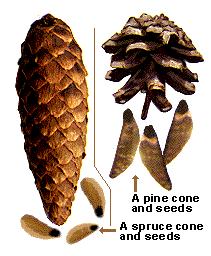
Bohemian waxwings and fieldfares are the most mutual eaters of rowan berries. They eat the fruit mankind simply seeds remain capable of germination after they have passed through the birds' intestines. This is how rowan spreads to new areas. However, bullfinches and pine grosspeaks dig the seeds out eating null more of the berry.
Eg. redpolls and bullfinchs eat the small-scale seeds of broad leaved copse and grass. The grass seed eaters are divided into two groups: goldfinches and greenfinches like to swallow burdocks ja thistles that take bigger seeds, whereas redpolls ja linnets eat smaller seeds. Even twigs, buds and bark from trees and bushes will do... Animals choose their food plants advisedly. Not only do they eat certain species of plants but they also often cull sure inviduals leaving other plants with less gnawing. More: Food plants! Broad leaved copse and bushes give many animals a vast supply of food. Especially in the winter herbivorous animals favor birches, willows, aspens and rowans. Hares and grouses avert birch buds every bit they seem to contain besides much bad-tasting resins. Many of our deer favor the leaves of bushes. Moose eats branches throughout the wintertime but early in the wintertime information technology can besides consume dward shrubs and ja grass. The white-tailed deer and roe deer cannot even get grass or twigs afterwards they have been covered with heavy snow. Eating branches does not satisfy the nutrition needs of these pocket-size deer through the whole winter, which prevents them from spreading north (if not fed past man). Moose survive well through the winter with branches. Reindeer and wild forest reindeer do non eat a lot of branches.
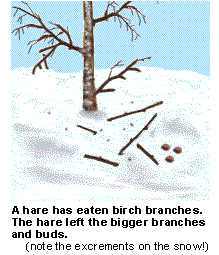
For the arctic hare (similarly to the moose), branches are enough to satisfy its daily energy requirements. As the snow comprehend thickens, hares tin accomplish higher and higher branches. Crown snow-load may also bend branches to its reach. The dark-brown hare eats mainly dark-green plants from under the snowfall, but can likewise resort to branches (eg. apple trees!).
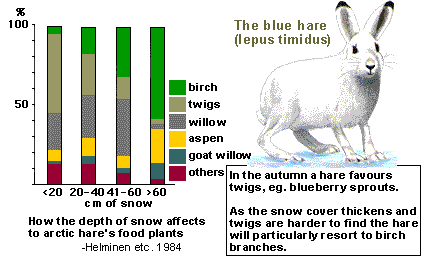
The grouse eats thin pieces of willow and birch branches in the winter. When the snowfall cover is sparse information technology may eat blueberry and dwarf birch twigs.
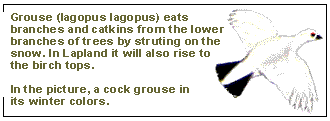
Animals eating the buds of broad leaved trees and bushes are the grouse (eats birch catkins and buds), partridge (alder catkins and buds) and bullfinch (eg. willow, if berries run out). Many animals - eg. moose, hares, willow grouses - swallow the buds of broad leaved trees the same time they eat pieces of branches. Hares and grouses avoid birch buds as they seem to contain too much bad-tasting resins.
Animals rarely swallow tree bawl except for emergency nutrition. When the hare population has grown big and nutrition is scarse, fifty-fifty a hare barks willows or other broad leaved trees. Sometimes (in northern Finland) it even resorts to eating the phloemof immature pines (like bark bread!). Hares (likewise as other mammals) eat the bark of treetops rather than the bark of the base of the tree if they tin only reach it (fallen trees, especially aspen and birch). Major part of the beaver's wintertime nutrition consists of the bark of broad leaved trees (aspen, big willows, birch). Moose barks broad leaved trees and even pines to satisfy its hunger. Information technology also rubs its antlers in the fall to revove skin from them (as reindeer do).
The pocket-size mammals field vole ja tundra vole consume tree bark under the snow (Willows, aspen, birch). From fourth dimension to fourth dimension field voles cause impairment to ornamental shrubs. Banking concern mole eats the bark of fallen copse (pine'southward and aspen's). In addition it climbs to young pines over the snow to eat their tops. See also the winter life of moles under and on top of snow! Particularly the bottoms of hawthorns and roses are sometimes completely eaten in the spring. The aboveground parts of these bushes dice merely new sprouts will grow equally long every bit the roots are not damaged. Run into likewise damage caused by the bank mole!
Though there are a lot of conifer tree needles in the forest they (mostly pino and juniper needles) are only good for a few animals. Pino needles are the capercaillie's but diet during the winter's menstruum of thick snow.
Needles are difficult to digest but capercaillies take long appendices, containing bacteria specialized in dissolving needles. The capercaillie chooses to consume the needles from a tree containing a lot of energy and little resin. Choosing the tree is especially of import considering the needles must contain as much energy equally possible and be easily digestible. Choosing the same trees over and over again crusade them to sparse out. During the winter, capercaillie eats approximately 150-200 grams of needles. Usually a full tum contains enough energy for the long winter night. In the winter, capercaillies avoid moving and spend ninety% of their time in a hollow where the temperature remains tolerable. Sometimes even a grouse eats the needles of a pine as well as thin branches.
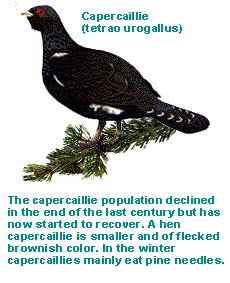
Spruce needles are rarely eaten past any creature (except sometimes past a hare). Moose and both of our hare species eat needles with thin juniper branches. Under the snow even a field vole may chew the juniper's thin branches.
Pines are the moose's ordinary winter food. It favors the branches of young (2-3 meter tall) pines causing damage in seedling stands. Normally pino survives despite the amercement caused by the moose, although curving and multiple tops may occur.
Hares may swallow pino needles in hunger specially in northern Republic of finland
Just very few species swallow the buds of conifer copse in the wintertime. Pine grosbeaks and squirrels are some of the rare spevcies that eat them frequently. Squirrels are most probable to swallow the staminate flower buds, nonetheless, this only occurs in bad cone years. Pine grospeaks have adult a special gustatory modality for bandbox buds. Sometimes, while climbing in copse, bank moles consume pino buds along with the bark.
It is not e'er easy to dig food from under the snow...
Getting food from under the snow depends on the thickness of the snow cover.
The brown hare and partridge mainly dig green plants from under the snow on fields. They both enjoy the sprouts of winter grain but other types of green will do as well. If the snowfall is too difficult after thaw, digging will not be possible. Emergency nutriotion tin can be found from winter juts (seeds), hay piles in barns or gardens (chocolate-brown hares eat eg. the bark of fruit trees). Neither of the species have spread to Lapland where the snow cover is plentiful and lasts long. Nevertheless, a reasonable amount of soft snow protects from the cold as well equally from predators. Even the partridge knows how to dig into snowfall to 'warm up itself'.
Reindeer and wild forest reindeer dig lichen from under the snow in the woods but in addition grass on fields and sedge in bogs (especially early in the wintertime). Earthworks snow for nothing really does not pay off to the reindeer! Reindeer at the Kuusamo surface area give up digging when the hardness of the snowfall is just about 100 chiliad/cm3, but in the Kittil� expanse they volition dig a lot harder snowfall. (virtually grand g/cm3). This difference may be explained by the fact that in Kuusamo there are culling types of nutrition to the reindeer to eat (eg. alectoria in conifer trees). Reindeer smells lichen through the snow! More: Reindeer!
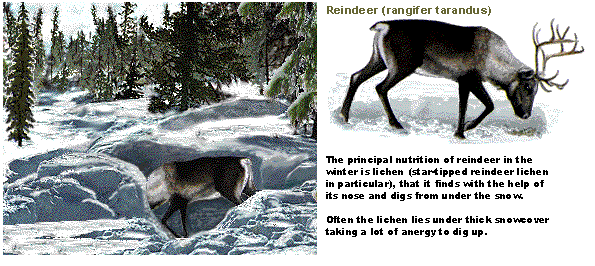
Source: https://www.oulu.fi/northnature/english/englanti/talvikansio/talviankara2.html
Posted by: chentropir.blogspot.com

0 Response to "What Kind Of Animals Eat Pine Trees"
Post a Comment